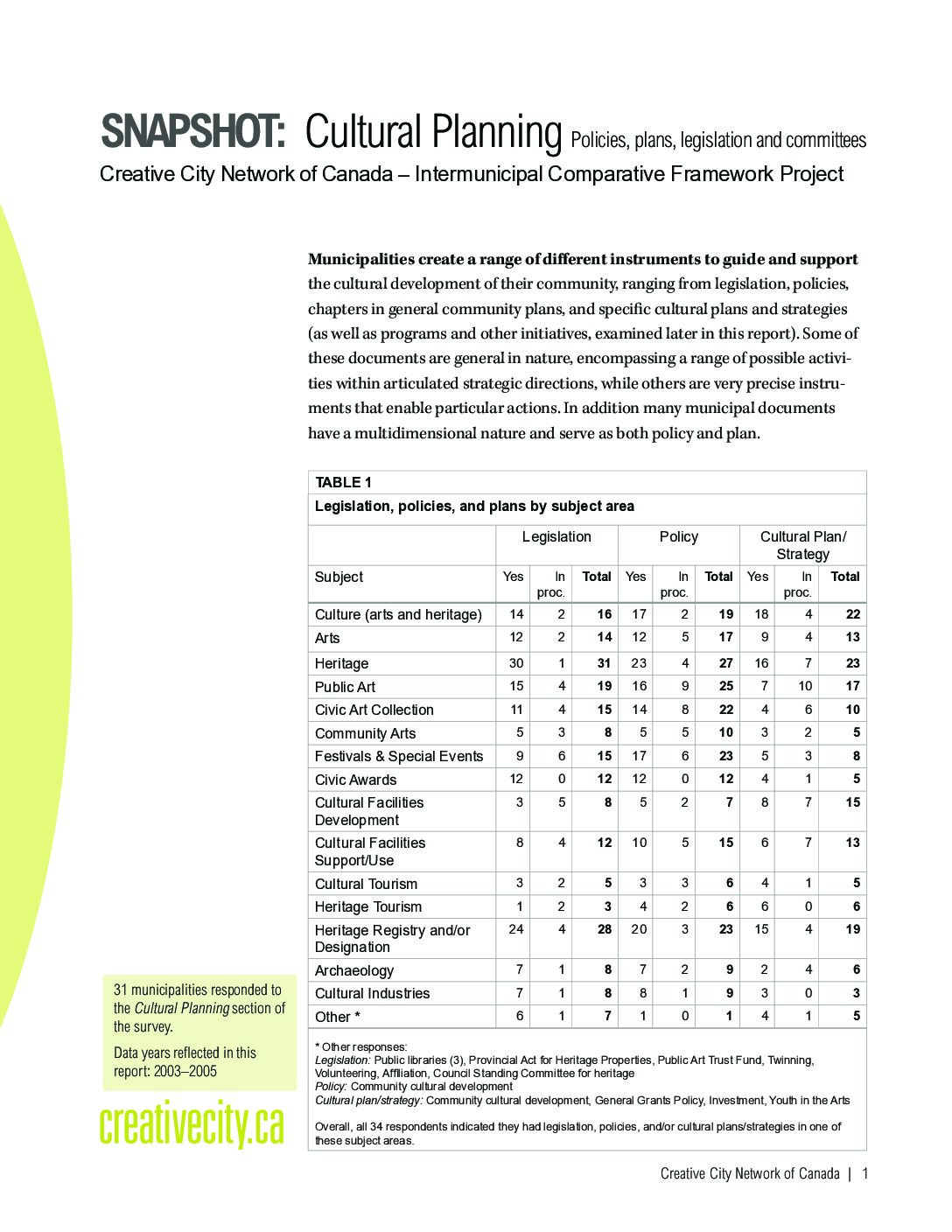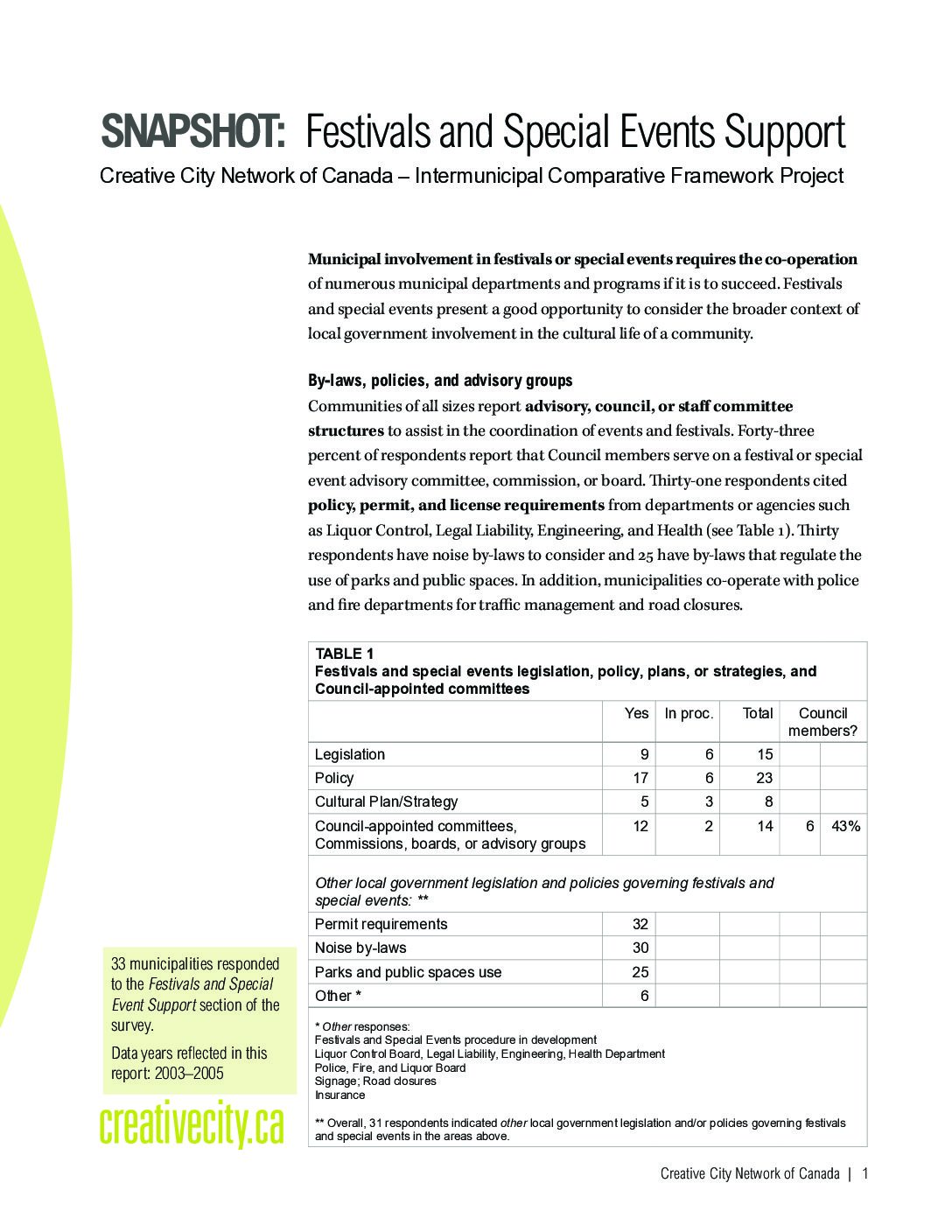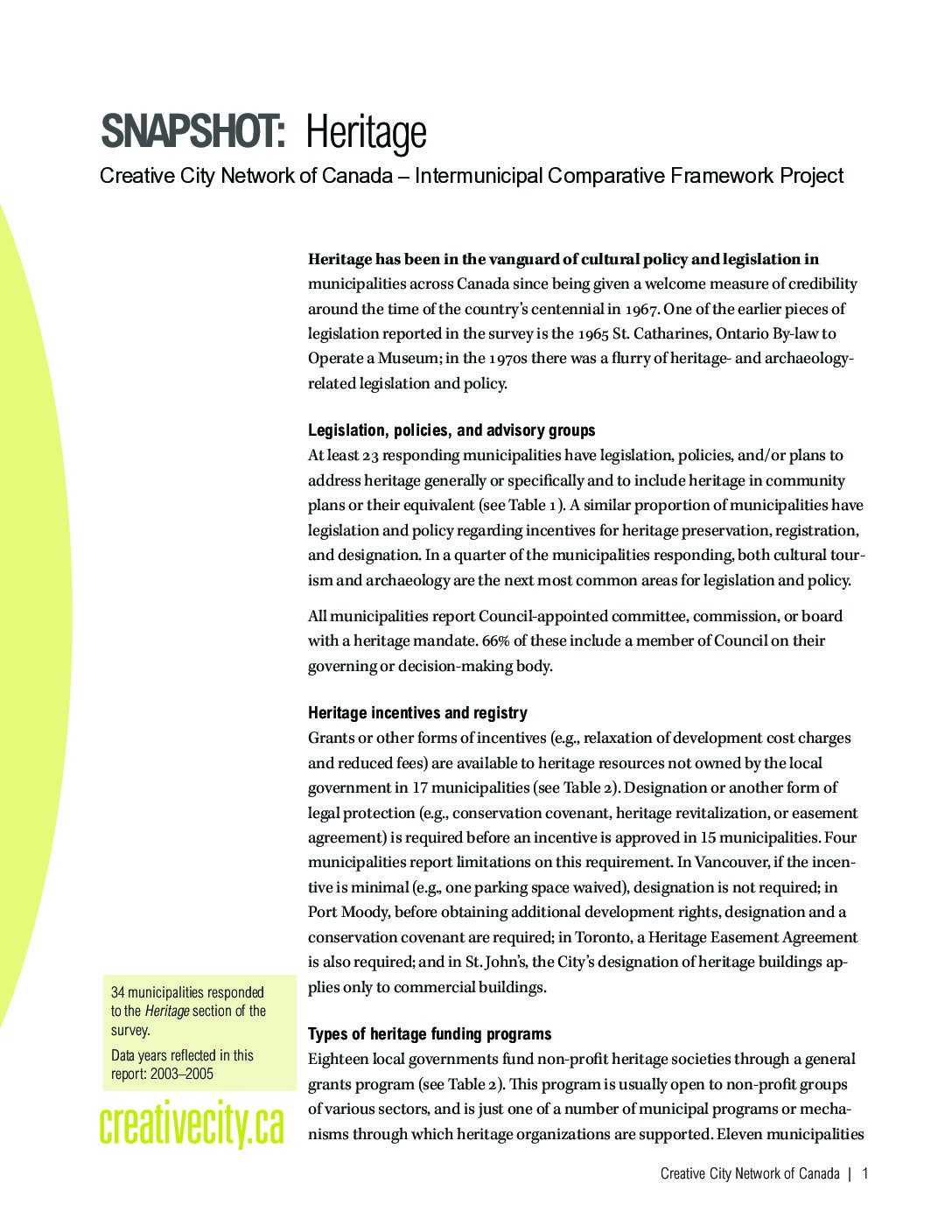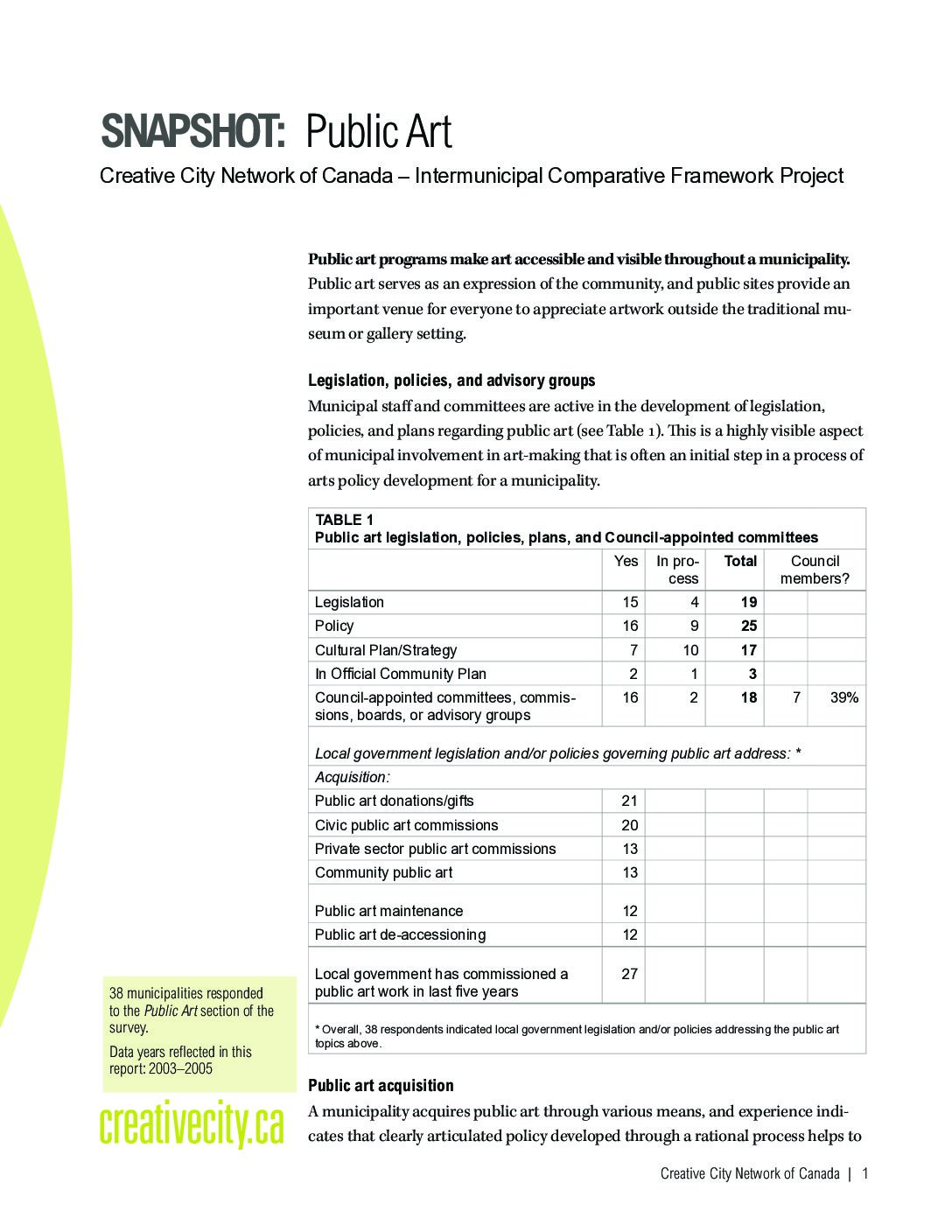Showing all 13 results
-

Executive Summary
The Intermunicipal Comparative Framework: An inventory of local government support to cultural development Executive Summary.
The Intermunicipal Comparative Framework Project is a means to inventory and understand the infrastructure, scope, and nature of local government involvement in cultural development across Canada. It creates the structure to capture the nature of local government involvement and investment in cultural development nationally. “Cultural development” is used here in an inclusive sense, and topics addressed in the project include arts, heritage, facilities, civic art collections, public art, funding, non-monetary support, and more.
-
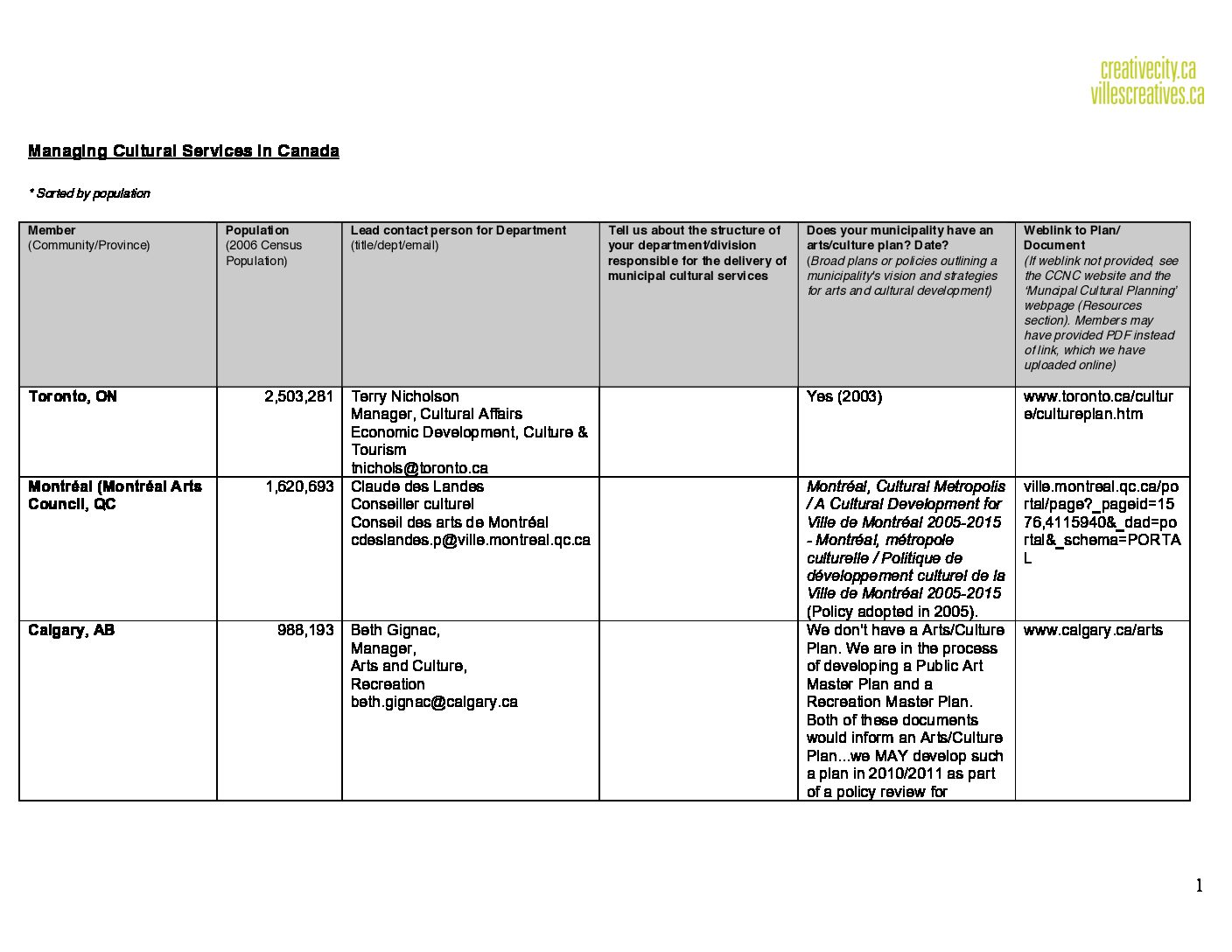
Managing Cultural Services in Canada (PDF)
A survey and inventory of municipal cultural plans/policies, as well as the structure and management of municipal cultural services.
-

Managing Cultural Services in Canada (XLS)
An inventory of civic owned and/or operated cultural facilities whose primary use is for the creation or exhibition of artistic activities (including but not limited to theatres, recital halls, rehearsal spaces, warehouse spaces dedicated to arts programming, amphitheatres, art galleries, art studios. It does not include museums and/or archives, live/work spaces, general parkland or fairgrounds, public art, private or not for profit owned cultural facilities, or community centres unless artistic programming and artistic activities are the primary user).
-
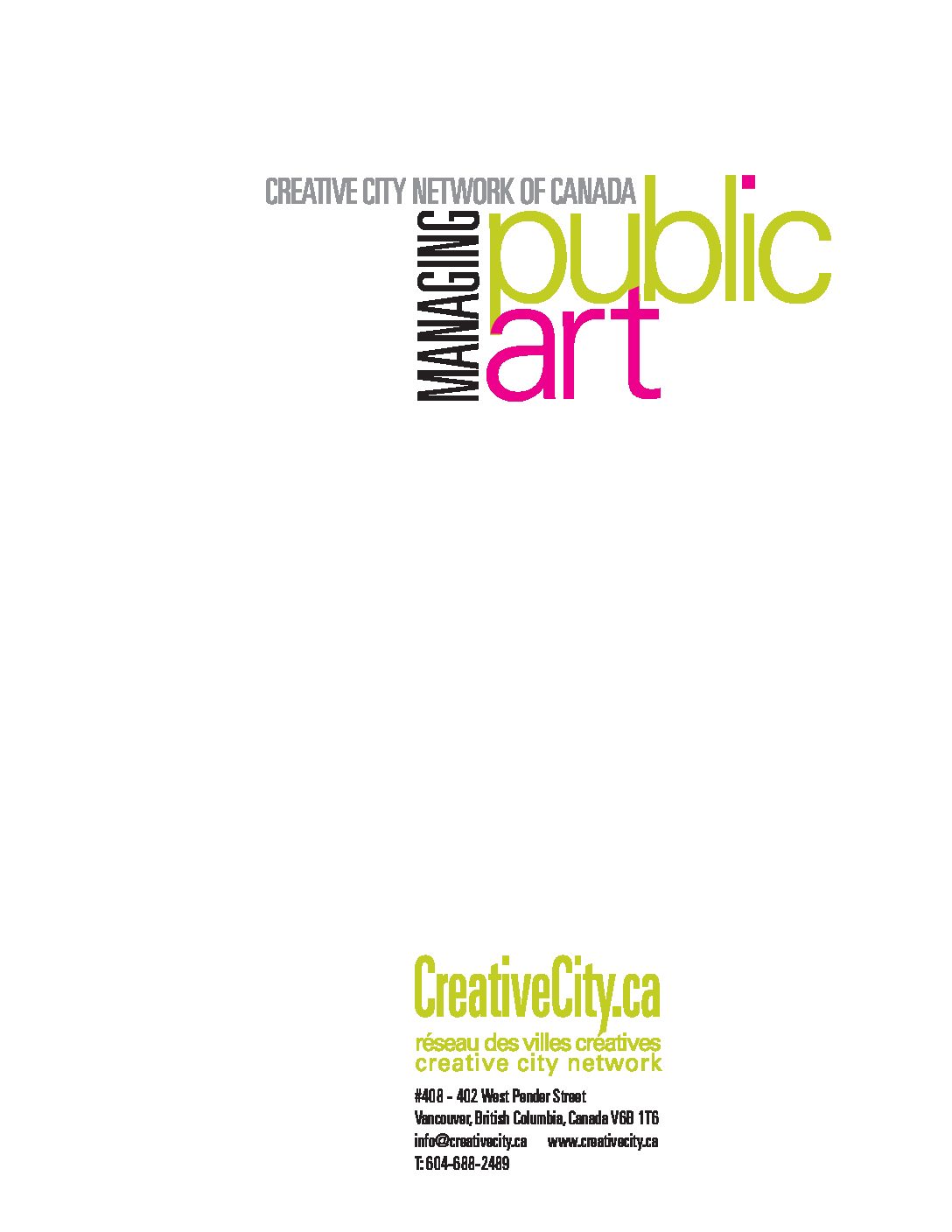
Managing Public Art – 264KB
A survey on municipal public art policies, plans, and programs and an inventory of public art installations in place and in development.
-
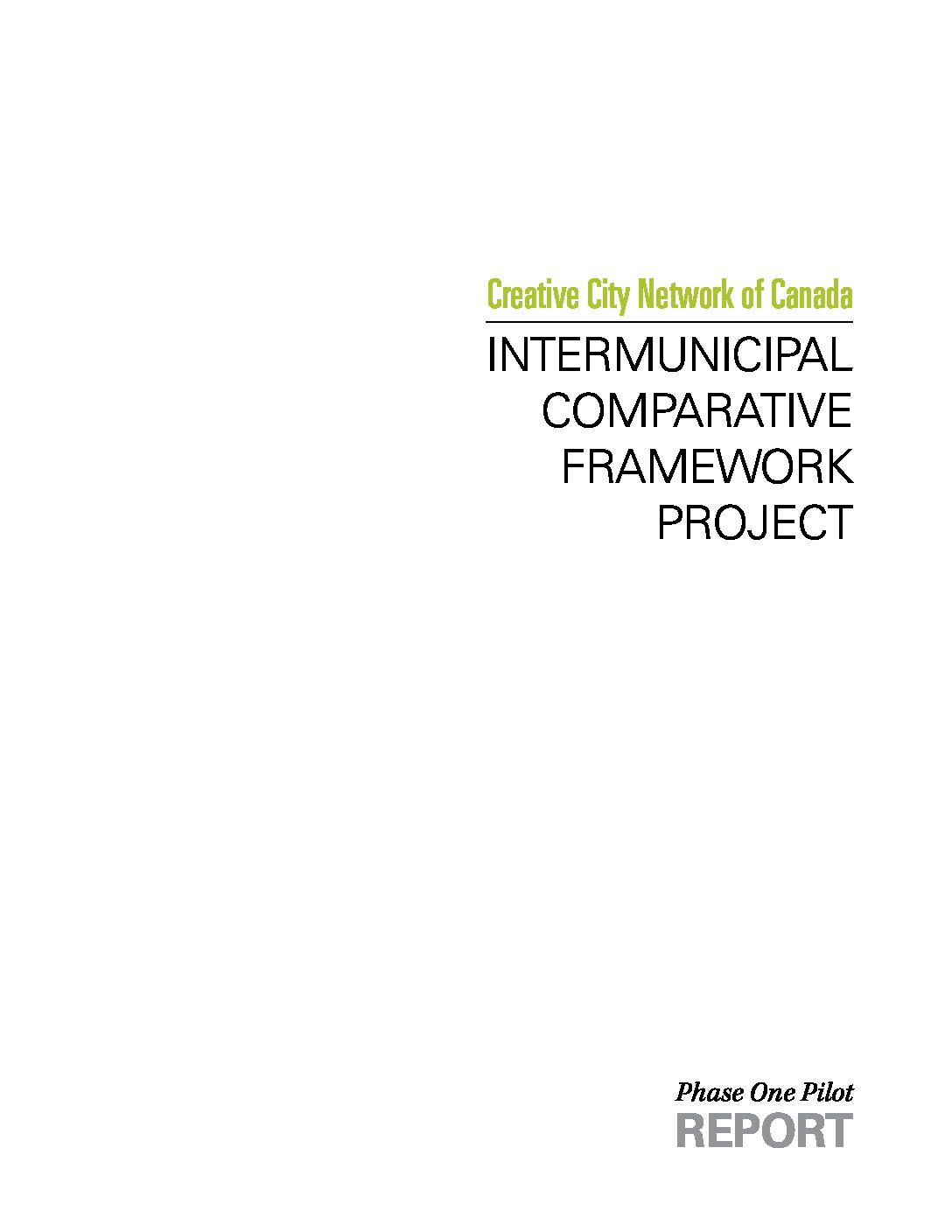
Phase One Pilot Report
The Intermunicipal Comparative Framework: An inventory of local government support to cultural development Phase One Pilot Report
The Intermunicipal Comparative Framework Project is a means to inventory and understand the infrastructure, scope, and nature of local government involvement in cultural development across Canada. It creates the structure to capture the nature of local government involvement and investment in cultural development nationally. “Cultural development” is used here in an inclusive sense, and topics addressed in the project include arts, heritage, facilities, civic art collections, public art, funding, non-monetary support, and more.
-

Snapshot: Arts Funding Programs
The Intermunicipal Comparative Framework: An inventory of local government support to cultural development; Snapshot: Arts Funding Programs
The Intermunicipal Comparative Framework Project is a means to inventory and understand the infrastructure, scope, and nature of local government involvement in cultural development across Canada. It creates the structure to capture the nature of local government involvement and investment in cultural development nationally. “Cultural development” is used here in an inclusive sense, and topics addressed in the project include arts, heritage, facilities, civic art collections, public art, funding, non-monetary support, and more.”
While municipal cultural grant programs are usually created and managed by municipal staff, some funding may be allocated or awarded to an independent non-profit organization in the community (e.g., a local arts council), which adjudicates and disburses the funds to local arts groups. Delegating the administration of program funds to these organizations has sometimes been a developmental stage for smaller communities, leading to a more formalized structure of local government arts programming supported by municipal staff. There are also examples of developing or using a sophisticated arm’s-length agency when funding major professional organizations in large urban centres. 38 municipalities responded to the Public Art section of the survey. Data years reflected in this report: 2003–2005
-
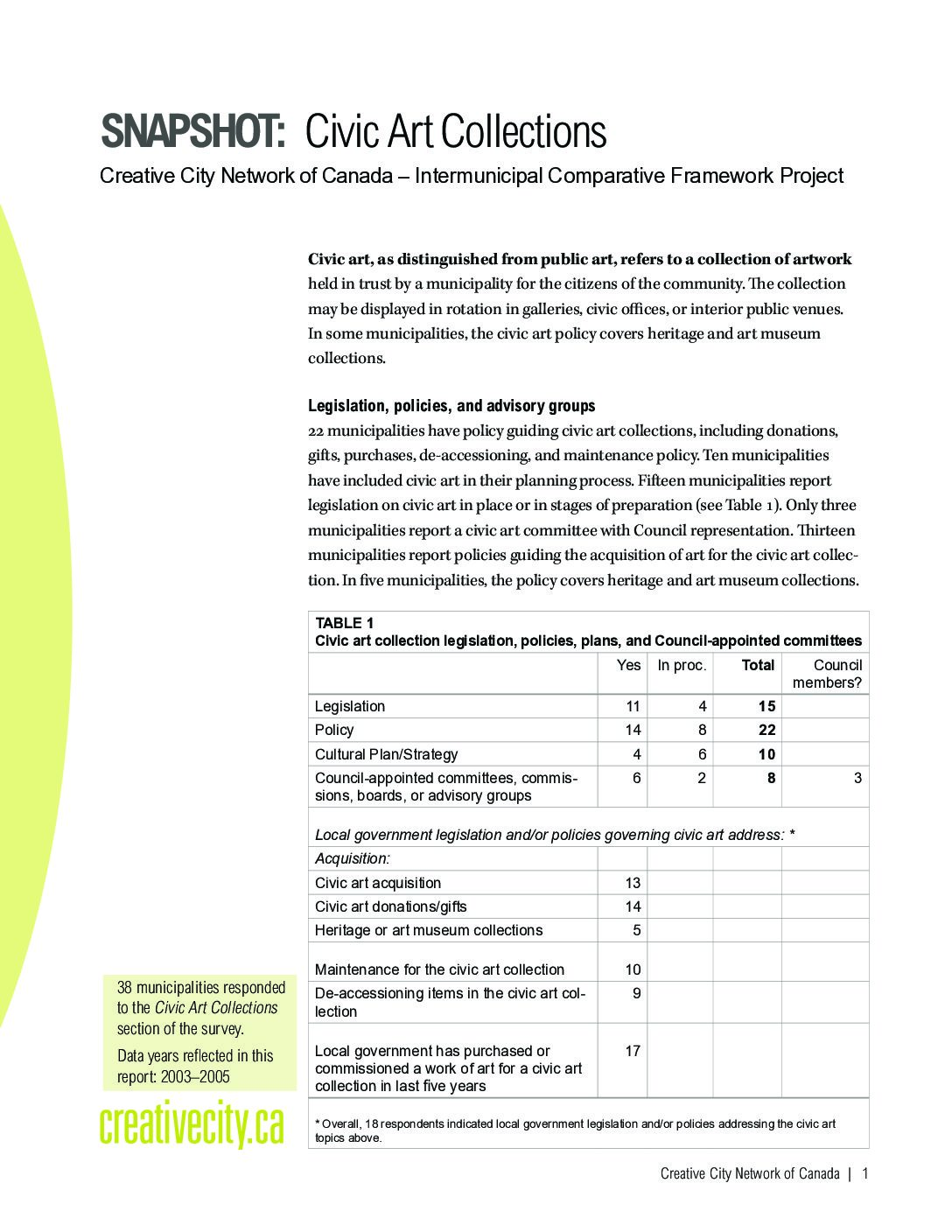
Snapshot: Civic Art Collections
The Intermunicipal Comparative Framework: An inventory of local government support to cultural development; Snapshot: Civic Art Collections
The Intermunicipal Comparative Framework Project is a means to inventory and understand the infrastructure, scope, and nature of local government involvement in cultural development across Canada. It creates the structure to capture the nature of local government involvement and investment in cultural development nationally. “Cultural development” is used here in an inclusive sense, and topics addressed in the project include arts, heritage, facilities, civic art collections, public art, funding, non-monetary support, and more.
Civic art, as distinguished from public art, refers to a collection of artwork held in trust by a municipality for the citizens of the community. The collection may be displayed in rotation in galleries, civic offices, or interior public venues. In some municipalities, the civic art policy covers heritage and art museum collections.
-
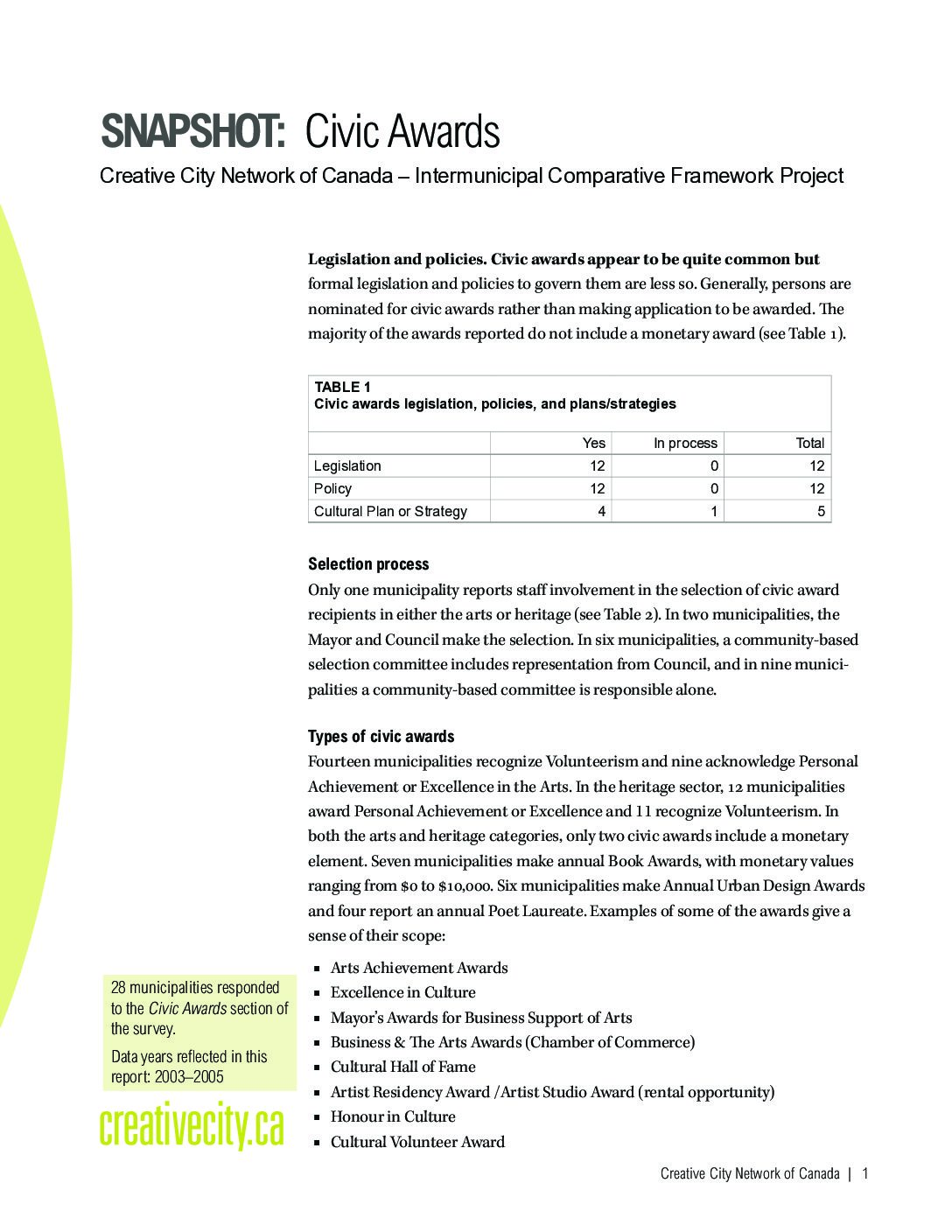
Snapshot: Civic Awards
The Intermunicipal Comparative Framework: An inventory of local government support to cultural development; Snapshot: Civic Awards
The Intermunicipal Comparative Framework Project is a means to inventory and understand the infrastructure, scope, and nature of local government involvement in cultural development across Canada. It creates the structure to capture the nature of local government involvement and investment in cultural development nationally. “Cultural development” is used here in an inclusive sense, and topics addressed in the project include arts, heritage, facilities, civic art collections, public art, funding, non-monetary support, and more.
Legislation and policies. Civic awards appear to be quite common but formal legislation and policies to govern them are less so. Generally, persons are nominated for civic awards rather than making application to be awarded. The majority of the awards reported do not include a monetary award.
-
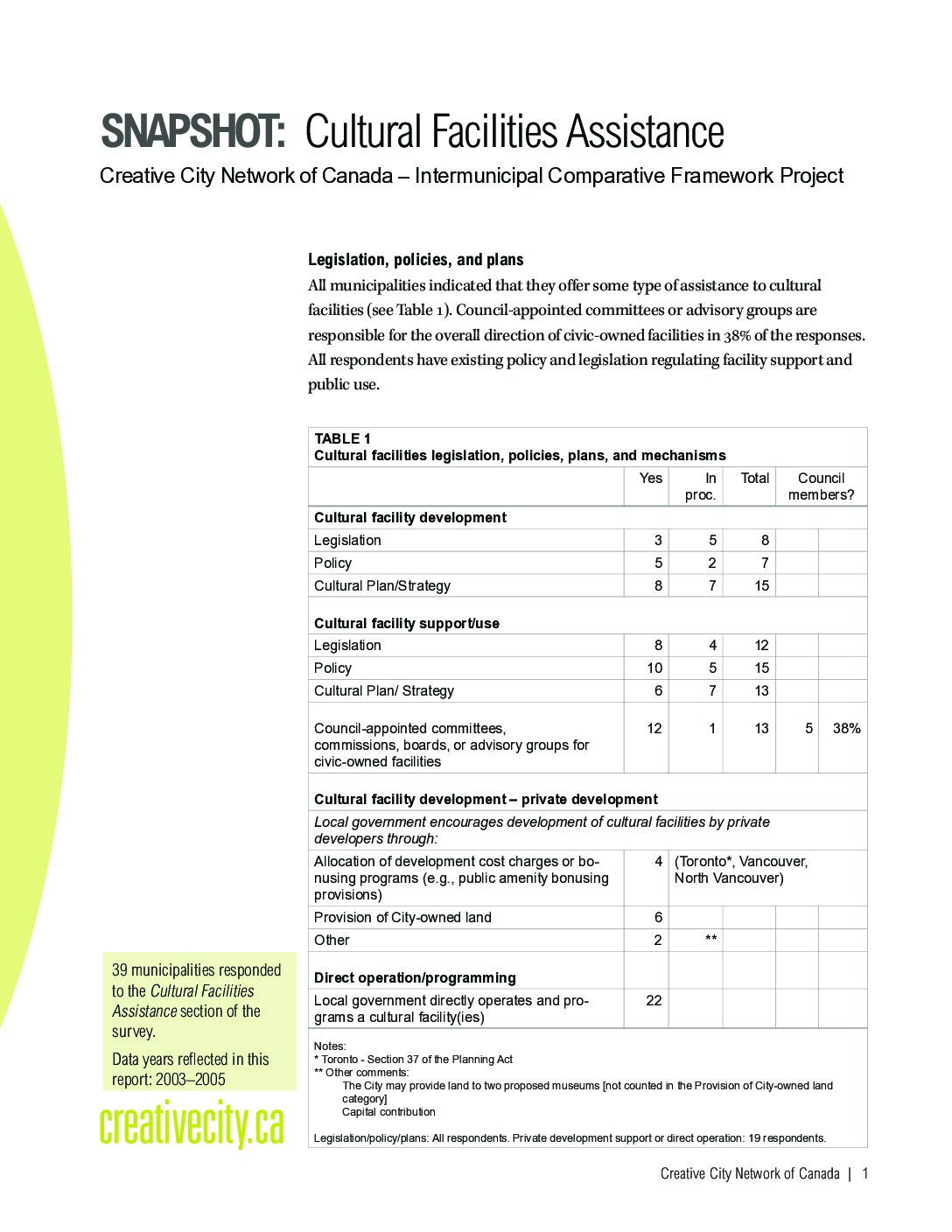
Snapshot: Cultural Facilities Assistance
Legislation, policies, and plans. All municipalities indicated that they offer some type of assistance to cultural facilities. Council-appointed committees or advisory groups are responsible for the overall direction of civic-owned facilities in 38% of the responses. All respondents have existing policy and legislation regulating facility support and public use. 39 municipalities responded to the Cultural Facilities Assistance section of the survey. Data years reflected in this report: 2003–2005
-
Snapshot: Cultural Planning
Municipalities create a range of different instruments to guide and support the cultural development of their community, ranging from legislation, policies, chapters in general community plans, and specific cultural plans and strategies (as well as programs and other initiatives, examined later in this report). Some of these documents are general in nature, encompassing a range of possible activities within articulated strategic directions, while others are very precise instruments that enable particular actions. In addition many municipal documents have a multidimensional nature and serve as both policy and plan. 31 municipalities responded to the Cultural Planning section of the survey. Data years reflected in this report: 2003–2005
-
Snapshot: Festivals and Special Events Support
Municipal involvement in festivals or special events requires the co-operation of numerous municipal departments and programs if it is to succeed. Festivals and special events present a good opportunity to consider the broader context of local government involvement in the cultural life of a community.
-
Snapshot: Heritage
Heritage has been in the vanguard of cultural policy and legislation in municipalities across Canada since being given a welcome measure of credibility around the time of the country’s centennial in 1967. One of the earlier pieces of legislation reported in the survey is the 1965 St. Catharines, Ontario By-law to Operate a Museum; in the 1970s there was a flurry of heritage- and archaeology- related legislation and policy.
-
Snapshot: Public Art
Public art programs make art accessible and visible throughout a municipality. Public art serves as an expression of the community, and public sites provide an important venue for everyone to appreciate artwork outside the traditional museum or gallery setting. 38 municipalities responded to the Public Art section of the survey. Data years reflected in this report: 2003–2005

